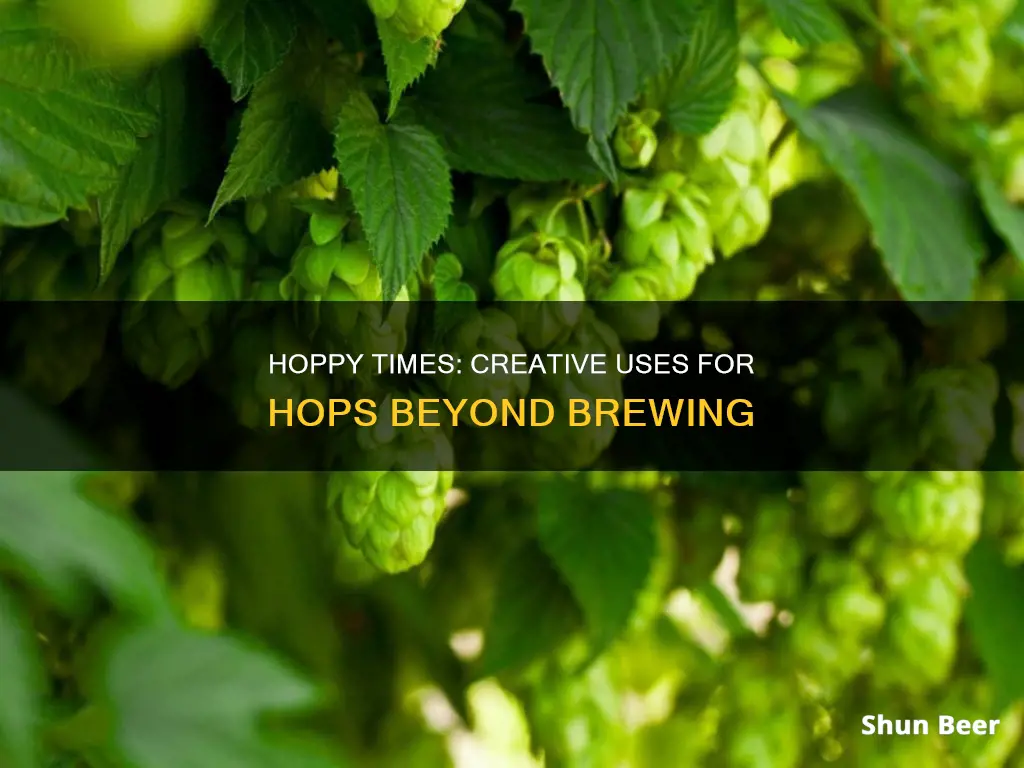
Hops are the flowers of the hop plant, Humulus lupulus, and are primarily used as a bittering, flavouring, and stabilising agent in beer. However, hops have various alternative uses beyond brewing beer. Fresh, dried, and pellet hops can be used to make teas, yeast, decorations, soaps, sauces, dressings, and more. Hops can also be eaten; young hop sprouts can be cooked and prepared like asparagus. Additionally, hops can be used in herbal medicine to provide relief for anxiety, restlessness, and insomnia.
| Characteristics | Values |
|---|---|
| Used in | Tea, yeast, decorations, garden additions, soap, sauces, dressings, herbal medicine |
| Appearance | Bine (similar to a vine) |
| Length | Up to 20 feet |
| Edible parts | Young hop sprouts |
What You'll Learn

Hops can be used to make tea
Hops are the flowers of the hop plant, which is a climbing perennial. They are most well-known for their use in brewing beer, but they have been used to make tea for just as long.
How to Make Hop Tea
To make hop tea, you'll need 5-10 hops cones, a tea kettle, a teapot, and hot (but not boiling) water. You can use fresh or dried hops, and you don't need a tea bag. Simply pour the hot water over the hops in your teapot and allow them to steep for about 15 minutes. You can add a lid to keep the medicinal properties from escaping in the steam. If you find the tea too bitter, you can add honey or another sweetener, or some complementary flavours such as citrus peels, chamomile, lemongrass, lemon balm, or ginger.
Medicinal Benefits of Hop Tea
Hop tea is often used as a bedtime tea due to its sedative properties. It is also said to have anti-inflammatory and antibacterial qualities, and to be a good treatment for anxiety and irritability. It can also be used as a hair or skin tonic.
Where to Get Hops
You can grow hops yourself, or buy them fresh or dried from a local farmer's market or a specialist online retailer.
Infusing Beer with Hops: A Step-by-Step Guide for Brewers
You may want to see also

They can be added to food, e.g. in salads, stews, or as a pizza topping
Hops are edible and can be used in cooking and baking to add a unique and delicious flavour profile to dishes. They are rich in nutrients and compounds that can contribute to a healthy diet. Hops are primarily known for their role in brewing beer, but they also have a place in many culinary creations. The unique flavours and aromas of hops add a wonderful dimension to various dishes and can be used in both sweet and savoury recipes.
The most popular culinary use of hops is in the form of hop-infused oils or vinegars. These can be used in dressings, marinades, and sauces to add a distinct hoppy flavour. Hops can be added to sauces and dressings to give them a subtle or bold hoppy flavour. Consider using hops in a barbecue sauce, salad dressing, or even a salsa.
Hops can also be used in baking recipes such as bread, cakes, and cookies. The bitter flavour can be balanced with sweet ingredients such as honey or maple syrup. Hoppy beer bread is a popular recipe that uses hops in baking. This bread has a subtle but distinct hoppy flavour, and the bitterness of the hops provides a balance to the sweetness of the bread.
One way to use hops in food is to add them to salads, stews, or as a pizza topping. Pull a few petals from the hop flower and add them to a soup, stew, or chilli in the same way you would add a bay leaf. The petals will provide some bitterness along with their unique aroma and flavour, so be careful to balance them with other ingredients. Outside the cooking process, hops could also be ground or minced and sprinkled directly onto dishes such as cauliflower mash or pizza, like oregano or basil. Just be careful not to add too much, as it can quickly overwhelm the other flavours!
Hops Beer: The Secret Behind the Bitter Buzz
You may want to see also

Hops can be used to make soap
When using hops in soap, it is important to note that the aroma may not survive the lye, and the hops may turn brown. Additionally, the hop-infused oil will be a deep green colour, which will give the soap a greenish hue.
To make hop soap, you will need a melt-and-pour soap base, which can be melted in a Bain-Marie or a microwave. The hops can then be added to the melted soap base, stirred through, and poured into a mould to set.
Hops are known to have natural anti-inflammatory properties and can act as a mild sedative, making them a great addition to soap.
Wet Hopping Beer: A Guide to Harvesting Fresh Hops
You may want to see also

They can be used to make yeast for breadmaking
Hops can be used to make yeast for breadmaking. This is a great option for people with baker's yeast allergies.
A hops yeast recipe from the 1890s White House Cook Book calls for hops, potatoes, and ginger. The potatoes act as food for the yeast, while the hops contain a chemical called lupulin, which keeps acetic and lactic bacteria in check and prevents their growth, resulting in a less sour taste. The role of ginger in this recipe is less clear, but it may inhibit bacterial growth in a similar way to hops.
A hops yeast recipe from a 1901 cookbook calls for boiling two ounces of hops in four quarts of water for half an hour, then straining and letting the mixture stand until lukewarm. At this point, add half a cup each of salt and brown sugar. The recipe concludes by saying: "this hops yeast ferments itself and does not need the aid of other yeast...will keep for up to two months and can be used to make excellent bread." However, one source notes that boiling hops for this length of time would kill any wild yeast.
Another hops yeast recipe from Paul Richards’ Pastry Book (1907) involves boiling a handful of hops in a quart of water for half an hour, straining the hops, and then putting the liquor in a strong bottle with a handful of malt and a little sugar. After 48 hours, this yeast will be ready to start about two gallons of stock.
A more detailed recipe for "Maiden Yeast" or "Malt Yeast" from the same book involves boiling half a pound of hops with four gallons of water for an hour, then cooling the mixture to 170° Fahrenheit and mashing with six pounds of malt for an hour. Add half a pound of sugar, strain the mixture into a yeast tub, and set it in a warm place, well covered. In 24 to 48 hours, when fermentation ceases, the yeast is ready for use. This recipe can be improved by stocking it with four ounces of compressed yeast, a quart of previous stock, or eight dry hop yeast cakes dissolved in water.
A more modern recipe for hop yeast involves simmering dried hops in six cups of water for about half an hour to make a strong tea. Sterilize a jar and lid in boiling water, then put 1.25 cups of whole wheat flour into the jar and strain the tea over it, stirring thoroughly. Cover the jar loosely and let it cool, then add .25 teaspoons of dry active yeast and stir. Allow the mixture to sit loosely covered to ferment for about 6-12 hours. When it’s done, put the lid on the jar and store it in a cool place.
Milwaukee Ice Beer: Hops or No Hops?
You may want to see also

Hops can be used as a home decoration
Garlands and Wreaths: Fresh or dried hop garlands can be used as decorations for weddings, funerals, or other events. They can also be hung in the home as a natural and rustic decoration. Dried hop garlands and wreaths are also available as carnival-inspired decorations, adding a festive touch to any space.
Hanging Stems and Bouquets: Hops can be used as hanging stems, adding a unique touch to any room. They can also be combined with other flowers or greenery to create beautiful bouquets or centrepieces.
Wall Decorations: Hops can be used to create wall decorations, such as hop prints or hop-themed posters. These can add a rustic or natural feel to any room.
Table Centerpieces: Hops can be used as part of a table centerpiece, especially when combined with other greenery or flowers. They can add texture and interest to a dining room or kitchen table.
Garden Decorations: Hops can be used to decorate outdoor spaces, such as venues or eating areas. The long vines can be draped or wrapped around structures to create a natural and whimsical look.
Fence and Wall Coverage: Hops are a climbing plant, so they can be used to cover up fences or walls in your garden or outdoor space. With a little training, hop plants can be directed to grow in certain directions, providing good coverage and a natural look.
There are many creative ways to use hops as home decorations, adding a unique and natural touch to any space. Whether used fresh or dried, hops can be a beautiful and versatile addition to your home decor.
Dry Hopping in Primary: A Guide for Beer Brewers
You may want to see also







